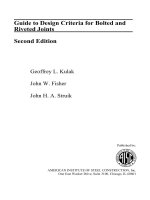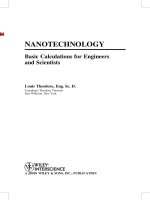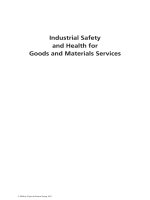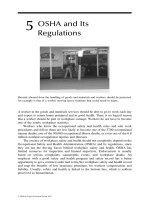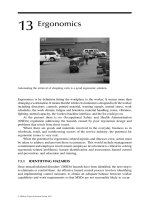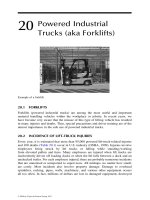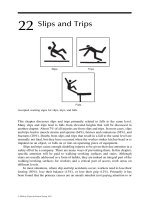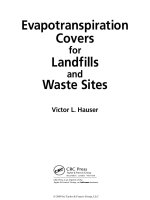Practical Design Calculations for Groundwater and Soil Remediation - Chapter 1 pptx
Bạn đang xem bản rút gọn của tài liệu. Xem và tải ngay bản đầy đủ của tài liệu tại đây (196.38 KB, 14 trang )
Kuo, Jeff "Frontmatter"
Practical Design Calculations
Boca Raton: CRC Press LLC,1999
©1999 CRC Press LLC
Practical Design Calculations
for Groundwater and
Soil Remediation
Jeff Kuo, Ph.D., P.E.
Civil and Environmental Engineering Department
California State University
Fullerton
©1999 CRC Press LLC
Library of Congress Cataloging-in-Publication Data
Kuo, Jeff.
Practical design calculations for groundwater and soil remediation
/ Jeff Kuo.
p. cm.
Includes bibliographical references and index.
ISBN 1-56670-238-0 (alk. paper)
1. Soil remediation—Mathematics—Problems, exercises, etc.
2. Groundwater—Purification—Mathematics—Problems, exercises, etc.
I. Title.
TD878.K86 1998
628.1
′
68—dc21 98-28646
CIP
This book contains information obtained from authentic and highly regarded sources. Reprinted
material is quoted with permission, and sources are indicated. A wide variety of references are listed.
Reasonable efforts have been made to publish reliable data and information, but the author and the
publisher cannot assume responsibility for the validity of all materials or for the consequences of their use.
Neither this book nor any part may be reproduced or transmitted in any form or by any means,
electronic or mechanical, including photocopying, microfilming, and recording, or by any information
storage or retrieval system, without prior permission in writing from the publisher.
The consent of CRC Press LLC does not extend to copying for general distribution, for promotion,
for creating new works, or for resale. Specific permission must be obtained in writing from CRC Press
LLC for such copying.
Direct all inquiries to CRC Press LLC, 2000 Corporate Blvd., N.W., Boca Raton, Florida 33431.
Trademark Notice:
Product or corporate names may be trademarks or registered trademarks, and
are used only for identification and explanation, without intent to infringe.
© 1999 by CRC Press LLC
Lewis Publishers is an imprint of CRC Press LLC
No claim to original U.S. Government works
International Standard Book Number 1-56670-238-0
Library of Congress Card Number 98-28646
Printed in the United States of America 1 2 3 4 5 6 7 8 9 0
Printed on acid-free paper
©1999 CRC Press LLC
About the author
Jeff (Jih-Fen) Kuo
worked in environmental engineering industries for over
10 years before joining the Department of Civil and Environmental Engi-
neering at California State University, Fullerton, in 1995. He gained his
industrial experiences from working at Groundwater Technology, Inc. (now
Flour-GTI), Dames and Moore, James M. Montgomery Consulting Engineers
(now Montgomery–Watson), Nan-Ya Plastics, and the Los Angeles County
Sanitation Districts. His industrial experiences in environmental engineering
include design and installation of air strippers, activated carbon adsorbers,
flare/catalytic incinerators, and biological systems for groundwater and soil
remediation; site assessment and fate analysis of toxics in the environment;
RI/FS work for landfills and Superfund sites; design of flanged joints to
meet stringent fugitive emission requirements; air emissions from waste-
water treatment; and wastewater treatment. Areas of research in environ-
mental engineering include dechlorination of halogenated aromatics by ul-
trasound, fines/bacteria migration through porous media, biodegradability
of bitumen, surface properties of composite mineral oxides, kinetics of acti-
vated carbon adsorption, wastewater filtration, THM formation potential of
ion exchange resins, and UV disinfection.
He received a B.S. degree in chemical engineering from National Taiwan
University, an M.S. degree in chemical engineering from the University of
Wyoming, an M.S. in petroleum engineering, and an M.S. and a Ph.D. in
Environmental Engineering from the University of Southern California. He
is a professional civil, mechanical, and chemical engineer registered in
California.
©1999 CRC Press LLC
to my wife Kathy, daughters Emily and Whitney, and my mom
©1999 CRC Press LLC
Contents
ChapterIIntroduction
I.1Background and Objectives
I.2Organization
I.3How to Use this Book
ChapterIISite Characterization and Remedial Investigation
II.0Introduction
II.1Determination of the Extent of Contamination
II.1.1 Mass and Concentration Relationship
II.1.2 Amount of Soil from Tank Removal or
Excavation of Contaminated Area
II.1.3 Amount of Contaminated Soil in the
Vadose Zone
II.1.4 Mass Fractiona and Mole Fraction of
Components in Gasoline
II.1.5 Height of the Capillary Fringe
II.1.6 Estimating the Mass and Volume of the
Free-Floating Product
II.1.7 Determination of the Extent of Contamination —
A Comprehensive Example Calculation
II.2Soil Borings and Groundwater Monitoring Wells
II.2.1 Amount of Cuttings from Soil Boring
II.2.2 Amount of Packing Materials and/or
Bentonite Seal29
II.2.3 Well Volume for Groundwater Sampling
II.3Mass of Contaminants Present in Different Phases
II.3.1 Equilibrium Between Free Product and Vapor
II.3.2 Liquid–Vapor Equilibrium
II.3.3 Solid–Liquid Equilibrium
II.3.4 Solid–Liquid–Vapor Equilibrium
II.3.5 Partition of Contaminants in Different Phases
ChapterIIIPlume Migration in Groundwater and Soil
III.1Groundwater Movement
III.1.1 Darcy’s Law
©1999 CRC Press LLC
III.1.2 Darcy’s Velocity vs. Seepage Velocity
III.1.3 Intrinsic Permeability vs. Hydraulic
Conductivity
III.1.4 Transmissivity, Specific Yield, and Storativity
III.1.5 Determine Groundwater Flow Gradient and
Flow Direction
III.2Groundwater Pumping
III.2.1 Steady-State Flow in a Confined Aquifer
III.2.2 Steady-State Flow in an Unconfined Aquifer
III.3Aquifer Test
III.3.1 Theis Method
III.3.2 Cooper–Jacob Straight-Line Method
III.3.3 Distance–Drawdown Method
III.4Migration Velocity of the Dissolved Plume
III.4.1 The Advection–Dispersion Equation
III.4.2 Diffusivity and Dispersion Coefficient
III.4.3 Retardation Factor for Migration in
Groundwater
III.4.4 Migration of the Dissolved Plume
III.5Contaminant Transport in the Vadose Zone
III.5.1 Liquid Movement in the Vadose Zone
III.5.2 Gaseous Diffusion in the Vadose Zone
III.5.3 Retardation Factor for Vapor Migration in
the Vadose Zone
ChapterIVMass Balance Concept and Reactor Design
IV.1Mass Balance Concept
IV.2Chemical Kinetics
IV.2.1 Rate Equations
IV.2.2 Half-Life
IV.3Types of Reactors
IV.3.1 Batch Reactors
IV.3.2 CFSTRs
IV.3.3 PFRs
IV.4Sizing the Reactors
IV.5Reactor Configurations
IV.5.1 Reactors in Series
IV.5.2 Reactors in Parallel
ChapterVVadose Zone Soil Remediation
V.1Soil Vapor Extraction
V.1.1 Introduction
V.1.2 Expected Vapor Concentration
V.1.3 Radius of Influence and Pressure Profile
V.1.4 Vapor Flow Rates
V.1.5 Contaminant Removal Rate
©1999 CRC Press LLC
V.1.6 Cleanup Time
V.1.7 Effect of Temperature on Soil Venting
V.1.8 Number of Vapor Extraction Wells
V.1.9 Sizing of Vacuum Pump (Blower)
V.2Soil Bioremediation
V.2.1 Description of the Soil Bioremediation Process
V.2.2 Moisture Requirement
V.2.3 Nutrient Requirements
V.2.4 Oxygen Requirement
V.3Soil Washing/Solvent Extraction/Soil Flushing
V.3.1 Description of the Soil Washing Process
V.4Low-Temperature Heating (Desorption)
V.4.1 Description of the Low-Temperature
Heating (Desorption) Process
V.4.2 Design of the Low-Temperature
Heating (Desorption) Process
ChapterVIGroundwater Remediation
VI.1Hydraulic Control (Groundwater Extraction)
VI.1.1 Cone of Depression
VI.1.2 Capture Zone Analysis
VI.2Above-Ground Groundwater Treatment Systems
VI.2.1 Activated Carbon Adsorption
VI.2.2 Air Stripping
VI.2.3 Advanced Oxidation Process
VI.2.4 Metal Removal by Precipitation
VI.2.5 Biological Treatment
VI.3In Situ Groundwater Remediation
VI.3.1 In Situ Bioremediation
VI.3.2 Air Sparging
ChapterVIIVOC-Laden Air Treatment
VII.1Activated Carbon Adsorption
VII.1.1 Adsorption Isotherm and Adsorption
Capacity
VII.1.2 Cross-Sectional Area and Height of GAC
Adsorbers
VII.1.3 Contaminant Removal Rate by the
Activated Carbon Adsorber
VII.1.4 Change-Out (or Regeneration) Frequency
VII.1.5 Amount of Carbon Required (On-Site
Regeneration)
VII.2Thermal Oxidation
VII.2.1 Air Flow Rate vs. Temperature
VII.2.2 Heating Values of an Air Stream
VII.2.3 Dilution Air
©1999 CRC Press LLC
VII.2.4 Auxiliary Air to Supply Oxygen
VII.2.5 Supplementary Fuel Requirements
VII.2.6 Volume of Combustion Chamber
VII.3Catalytic Incineration
VII.3.1 Dilution Air
VII.3.2 Supplementary Heat Requirements
VII.3.3 Volume of the Catalyst Bed
VII.4Internal Combustion Engines
VII.4.1 Sizing Criteria/Application Rates
VII.5Soil Beds/Biofilters
VII.5.1 Design Criteria
©1999 CRC Press LLC
Preface
The focus of the hazardous waste management business has switched in
recent years from litigation and site assessment to remediation. Site restora-
tion usually proceeds through several phases and requires a concerted, mul-
tidisciplinary effort. Thus, remediation specialists have a variety of back-
grounds, including geology, hydrology, chemistry, microbiology,
meteorology, toxicology, and epidemiology as well as chemical, mechanical,
electrical, civil, and environmental engineering. Because of differences in the
formal education of these professionals, their ability to perform or review
remediation design calculations varies considerably. For some, performing
accurate design calculations can become a seemingly insurmountable task.
Most, if not all, of the books dealing with site remediation provide only
descriptive information on treatment technologies, and none, in my opinion,
provide helpful guidance on illustrations of design calculations. This book
was written to address the current needs of practicing engineers, scientists,
and legal experts who are employed by industry, consulting companies, law
firms, and regulatory agencies as well as university seniors and graduate
students in the field of soil and groundwater remediation. It provides prac-
tical and relevant working information, derived from the literature and from
my own hands-on experiences in consulting and teaching in this field. I
sincerely hope that this book becomes a useful tool for the professionals and
students working in site remediation. Your comments and suggestions are
always welcome, and my e-mail address is
Finally, I would like to take this opportunity to thank Tom Hashman
and Ziad El Jack of the Sanitation Districts of Los Angeles County for re-
viewing the manuscript and providing valuable comments.
Kuo, Jeff "Introduction"
Practical Design Calculations for Groundwater and Soil Remediation
Boca Raton: CRC Press LLC,1999
©1999 CRC Press LLC
chapter one
Introduction
I.1 Background and objectives
The hazardous waste management business has steadily increased since the
early 1980s as public concern led to a vast range of new environmental
regulations. During much of this period, a substantial amount of time and
expense has been devoted to studying contaminated sites, with much of the
expense dedicated to litigation to determine the financially responsible par-
ties. However, the focus has switched in recent years from litigation and site
assessment to remediation. Site restoration usually proceeds through several
phases and requires a concerted, multidisciplinary effort. Thus, remediation
specialists have a variety of backgrounds, including geology, hydrology,
chemistry, microbiology, meteorology, toxicology, and epidemiology as well
as chemical, mechanical, electrical, civil, and environmental engineering.
Because of differences in the formal education of these professionals, their
ability to perform or review remediation design calculations varies consid-
erably. For some, performing accurate design calculations can become a
seemingly insurmountable task.
The absence of uniformly trained specialists is exacerbated by the con-
tinuously evolving remediation technology. For instance, remediation tech-
nologies such as soil venting and bioremediation are now generally accept-
able to environmental professionals, while just a few years ago they were the
subject mainly of research articles. While up-to-date design information is
sporadically published in the literature, it is usually theoretical in nature and
illustrative applications are rarely given. Most, if not all, of the books dealing
with hazardous waste management and site remediation provide only
descriptive information on treatment technologies, and none, in this author’s
opinion, provide helpful guidance on illustrations of design calculations.
Without the proper education, environmental professionals can exert
themselves, needlessly reinventing the wheel, so to speak, and err in their
©1999 CRC Press LLC
design calculations. This book was written to address the current needs of
practicing engineers, scientists, and legal experts who are employed by
industry, consulting companies, law firms, and regulatory agencies in the
field of soil and groundwater remediation. It covers important aspects of the
major design calculations used in this field and also provides practical and
relevant working information derived from the literature and the author’s
own experience. Realistic examples are used liberally to illustrate the appli-
cation of the design calculations. This book can also serve as a supplementary
textbook or reference book for university seniors and graduate students who
would like to have an overview of remediation design calculations.
I.2 Organization
The book is divided into the following chapters:
Chapter two: Site Assessment and Remedial Investigation. This chapter
illustrates engineering calculations needed during site assessment
and remedial investigation. It begins with simple calculations for
estimating the amount of contaminated soil excavated and that left
in the vadose zone and size of the contaminated plume in the aquifer.
This chapter also describes necessary calculations to determine par-
titioning of contaminant mass in the different phases, which is critical
for remediation design.
Chapter three: Groundwater Movement and Plume Migration. This
chapter illustrates how to estimate the rates of groundwater move-
ment and plume migration. The reader will also learn how to interpret
the aquifer test data and estimate the age of a groundwater plume.
Chapter four: Mass Balance Concept and Reactor Design. This chapter
first introduces the mass balance concept, followed by reaction kinet-
ics, as well as types, configuration, and sizing of reactors. The reader
will learn how to determine the rate constant, removal efficiency,
optimal arrangement of reactors, required residence time, and reactor
size for one’s specific applications.
Chapter five: Vadose Zone Soil Remediation. This chapter provides im-
portant design calculations for commonly used in situ or above-
ground soil remediation techniques, such as soil vapor extraction, soil
washing, and soil bioremediation. Taking soil venting as an example,
the book will guide the reader through design calculations for radius
of influence, well spacing, air flow rate, extracted contaminant con-
centrations, effect of temperature on vapor flow, cleanup time, and
sizing of vacuum blowers.
Chapter six: Groundwater Remediation. This chapter starts with design
calculations for capture zone and optimal well spacing. The rest of
the chapter focuses on design calculations for commonly used in situ
or ex situ groundwater remediation techniques, including bioremedi-
©1999 CRC Press LLC
ation, air sparging, air stripping, advanced oxidation process, and
activated carbon adsorption.
Chapter seven: VOC-Laden Air Treatment. Remediation of contaminated
soil and groundwater often results in transferring organic contami-
nants into the air phase. Development and implementation of an air
emission control strategy are an integral part of the overall remedia-
tion program. This chapter illustrates design calculations for com-
monly used off-gas treatment technologies such as activated carbon
adsorption, direct incineration, catalytic incineration, IC engines, and
biofiltration.
I.3 How to use this book
The book is constructed to provide a comprehensive coverage of commonly
used soil and groundwater remediation technologies. It is written in a cook-
book style and user-friendly format. Both SI and U.S. customary units are
used throughout the book, and unit conversions are frequently given. Exam-
ples are given following the design equations. Some of the examples are
provided to illustrate important design concepts. One of the best ways to
use the book is to glance through the entire book first, by reading the text
and skimming the problem statement and discussion only, and revisit the
specific topics in detail later when related design calculations are to be made.
